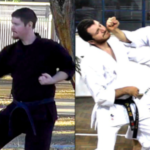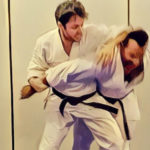We have talked a lot about the centrality of close range fighting in self defense and, consequently, in historical karate. We have already demonstrated many applications/bunkai of kata with an emphasis on offensive (and control) potential at close range, such as in here. But what about the defensive part? Isn’t it much harder to defend yourself in the close range?
In fact, in the first place, as we have discussed here before, in a situation of self-defense (that is, in old style karate karate), the defender rarely even has the chance to choose not to fight at close range. If you are really in a self-defense situation (and not in a street brawl or sports situation), you will almost always simply be forced to fight at close range. Second, in reality, it is often much easier to defend against an attacker at close range! I imagine that this statement may seem unexpected, but I will prove what I am saying (in Muidokan we prove everything we say). But to get that defensive advantage at close range, we have to use the historical principles that old style karate teaches. Among some of the historical oral teachings (kuden 口伝) that I have cataloged over the years and that I apply and teach in Muidokan, are:
- Muchimi ムチミ/もち身. “Mochi もち body”: karateka’s body quality with danryokusei 弾力性: sticky, elastic, adaptable and resilient;
- Chiru nu chan chan チルヌチャンチャン. Instant reaction based on tactile sensitivity provided by muchimi;
- Meotode 夫婦手. “Married hands”: continuous and active use of both hands together;
- Kake-ai 掛合. “Contact harmony”: the ability to integrate short distance techniques in harmony with each other.
- Suemono ni suru 据え物にする. “Turn your opponent into suemono 据え物”. Paralyzing the opponent and then striking them.
I will talk more about each of these principles (and many others) in future articles, so keep following our posts!
You can see the practical application of these principles and the incredible defensive power of ancient karate in the video below:
In the light of all that has been shown, I would like to make some final remarks:
* I emphasize again that what we do here is not guesswork or invention. This is the result of a serious 10-year research, strictly faithful to the kata and the teachings available from countless authentic historical sources, some of which only available in individual contacts with masters, or checked directly in the original Japanese documents.
* All of our material has been exhaustively tested under pressure — including against practitioners of other martial arts and sometimes even in uncontrolled situations. These techniques are also tested again by other members of Muidokan (we apply the peer review system typical of scientific method). We only work with proven techniques.
* Take care when trying the techniques. It is always better to have a qualified instructor to guide you. When the pandemic isolation period passes, Muidokan will offer seminars again, and associated schools and training groups will offer regular classes once more.
If you like our content, please comment, like and share. Follow us on our social media (links at the top of this page). Karate is undergoing a revolution with the rediscovery of its true historical techniques. Be part of the karate revolution by helping to bring this information to more people. This process is inevitable — karate will never be the same. And you can be an active part of that restoration!
Thanks again for the support. Keep it up, and great training everyone!
Samir Berardo




Pingback: Video: kakedameshi, historical teachings of karate and hontou bunkai – Muidokan Karate Kenkyukai
Pingback: ARTICLE | Kake-Kumite/Kakedameshi: The original free sparring of Karate
Pingback: Kake-Kumite/Kakedameshi: El Combate Libre Original de Karate
Pingback: Old school karate stickiness techniques seen in MMA! – Muidokan Karate Kenkyukai
Pingback: Kake-Kumite/Kakedameshi: The original free sparring of Karate
Pingback: Fundamental technical concepts of old style karate – Muidokan Karate Kenkyukai